7 - Benin, Nigeria
1/38
Earn XP
Description and Tags
Name | Mastery | Learn | Test | Matching | Spaced |
|---|
No study sessions yet.
39 Terms
Benin, Nigeria (Periods/Cultures/Kingdoms)
Kingdom: Kingdom of Benin (c. 1,200CE - 1,897CE)
Culture: Benin Post-Exile (c. 1,914CE - present)
Benin (location)
Nigeria
Kingdom of Benin (dates)
c. 1,200CE - 1,897CE
Kingdom of Benin (c. 1,200CE - 1,897CE) notes
Ibini (c. 9th century)
dysfunctional dynasty
“Ibini” = “Land of Vex”
their Ogiso dies and they ask Ife to take them over
Prince Oramniyan from Ife-Ife comes and takes over, becoming the first Oba of Benin
Benin (1,200CE - 1,897CE)
part of Edo culture (speak Edo language; Edo culture encompasses multiple kingdoms)
primary art types:
bronze commemorative heads, plaques, and figures
ivory pendant masks
coral bead regalia
all exclusive materials to the royal family
Artwork ID: “Head of an Oba”
Kingdom: Kingdom of Benin
Location: Nigeria
Dates: c. 1,200CE - 1,897CE
Medium: brass

“Head of an Oba” notes
somewhat abstracted facial features (but it only gets more abstracted from here)
hair is incredibly detailed compared to everything else
very important feature
ikharo marks above eyebrows (on other heads, not this one specifically)
3 = male, 4 = female or foreigner
face doesn’t indicate gender otherwise
similar to bronze heads from Ife
Possible influence from Oba Oranmiyan
Artwork ID: “Bronze Plaque Depicting Oba Ohen”
Kingdom: Kingdom of Benin
Location: Nigeria
Dates: c. 1,200CE - 1,897CE
Medium: brass
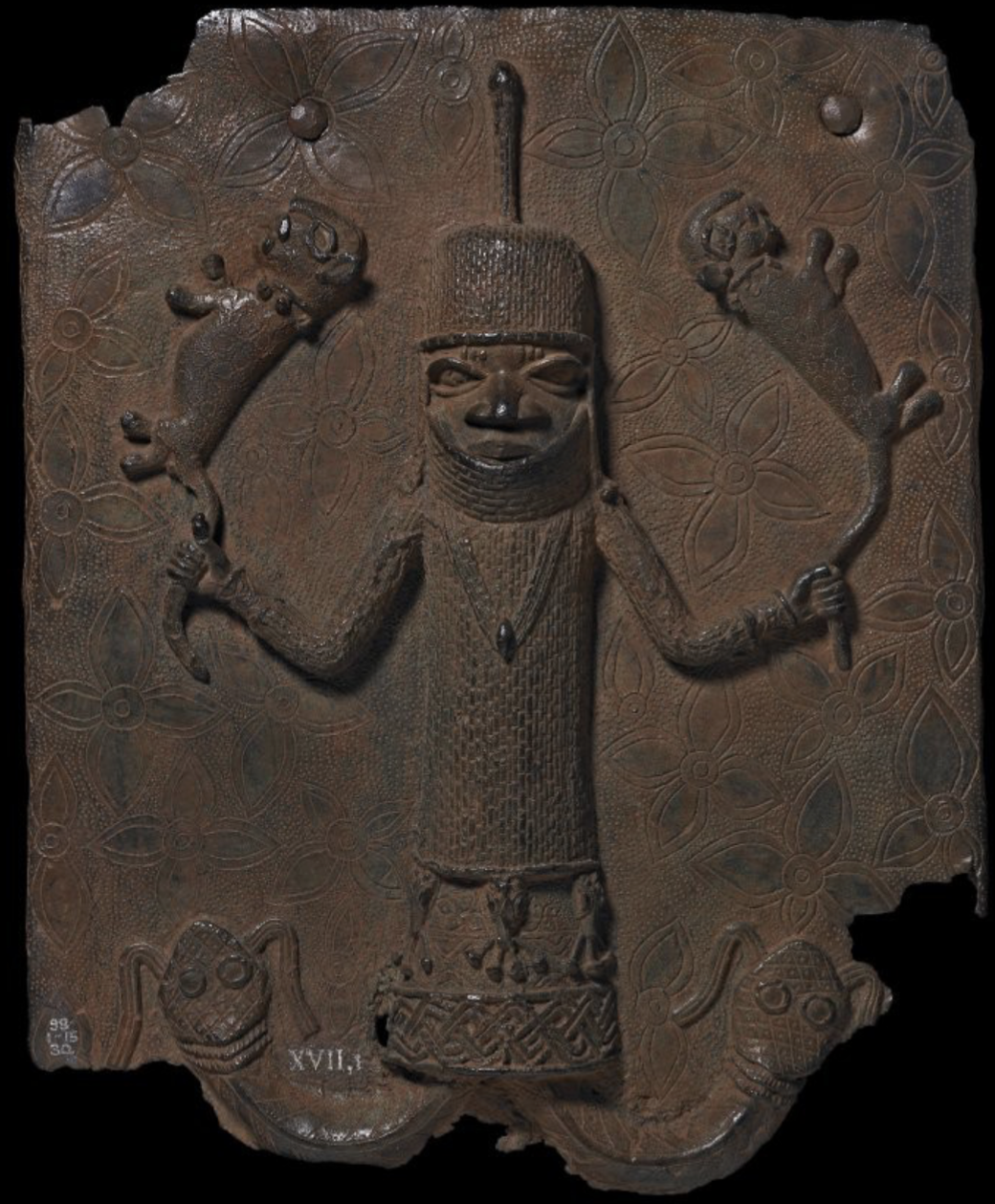
“Bronze Plaque Depicting Oba Ohen” notes
fish for legs
visual metaphor for his disability
hid his legs from his court, killed the man that found out his secret
got in trouble b/c the Oba is not above the law
became a cautionary tale
Artwork ID: “Tableau Portrait of Oba Ozolua, The Conqueror”
Kingdom: Kingdom of Benin
Location: Nigeria
Dates: c. 1,200CE - 1,897CE
Medium: wood/drawing of wooden stool

“Tableau Portrait of Oba Ozolua, The Conqueror” notes
Omada style -> more cartoonish
“warrior king” message
usually depicted holding half of a human body, heads, and weapons
not well-liked by his subjects and soldiers
one of his chiefs maimed his arm to “slow him down”
arm is covered in most portraits with a shield (uncovered in this one b/c the artist was one brave bastard)
2 women’s hands holding mirrors
Ekpate = women employed to stay in the palace and protect the king from spiritual attacks
one of the most powerful spiritual weapons was the mirror
2 leopards represent his father
giant floating coral bead
calls him out for not fulfilling his spiritual duties + focusing too much on warfare
Artwork ID: “Palace Altar to an Oba”
Kingdom: Kingdom of Benin
Location: Nigeria
Dates: c. 1,200CE - 1,897CE
Medium: ivory and bronze
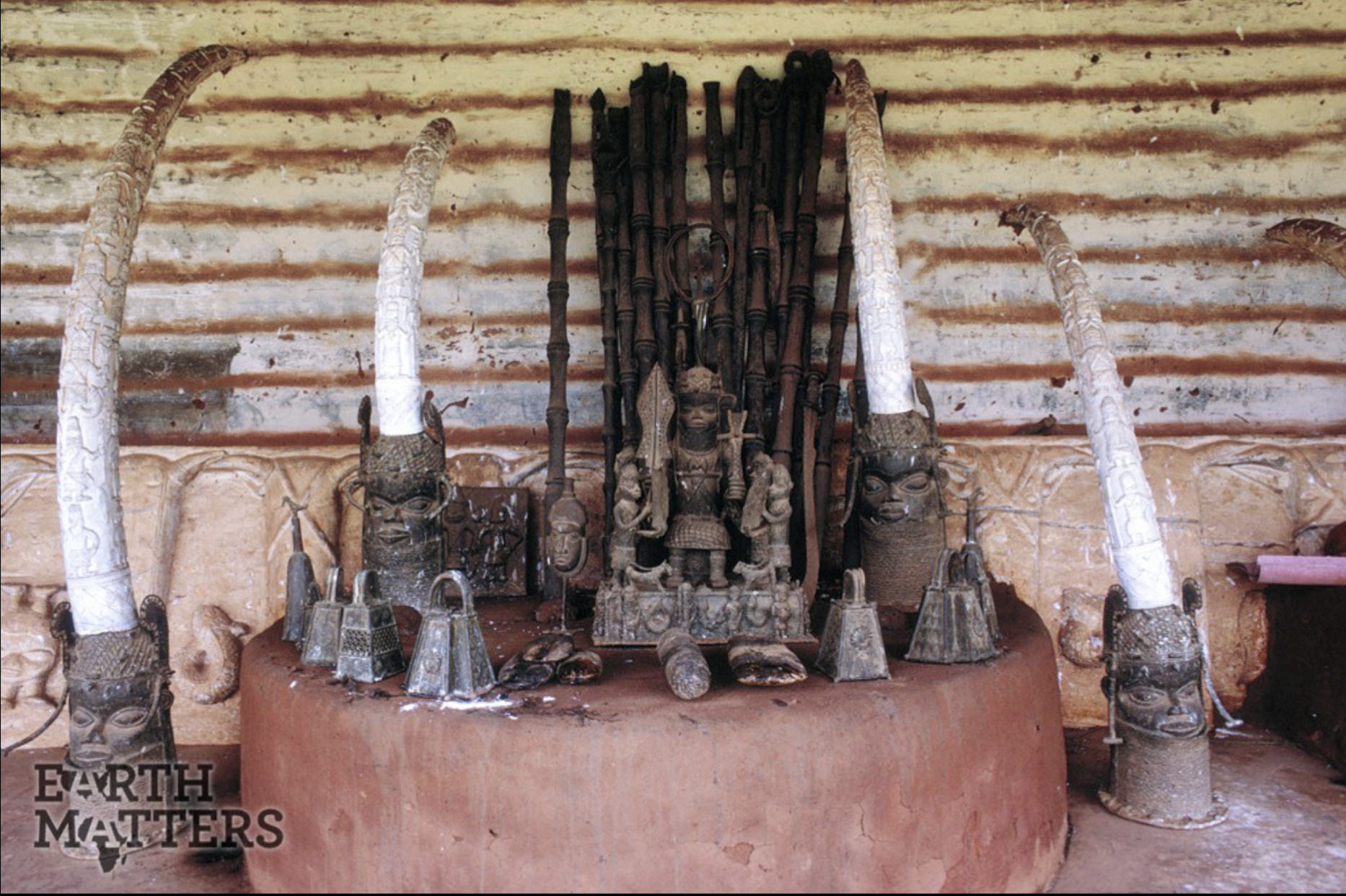
“Palace Altar to an Oba” notes
palace shrine to the Oba
dismantled by the British during the Benin Massacre (but they had the decency to photograph it first apparently)
Artwork ID: “Ivory Mask of Iyoba Idia”
Kingdom: Kingdom of Benin
Location: Nigeria
Dates: c. 1,200CE - 1,897CE
Medium: ivory, iron, and bronze
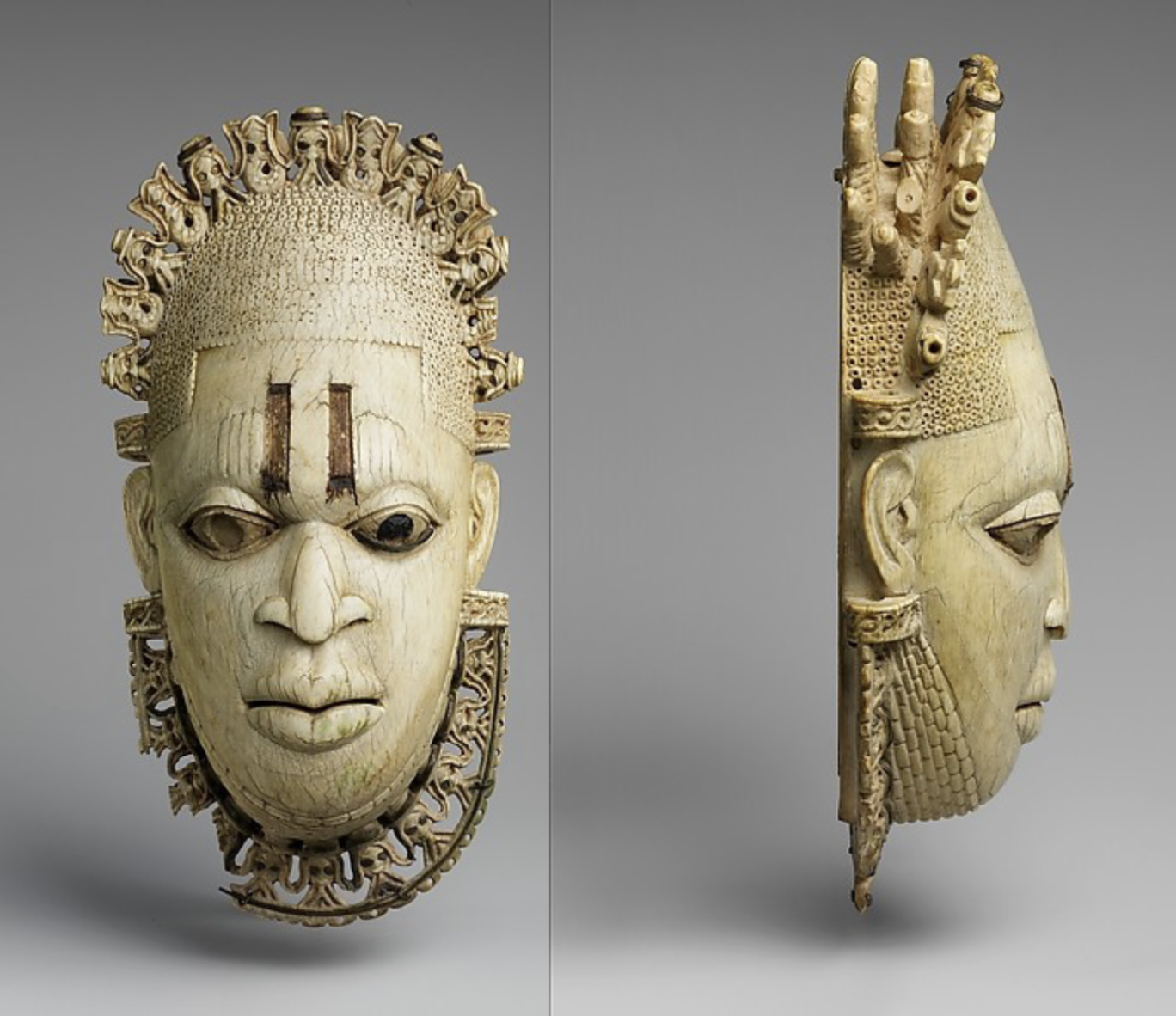
“Ivory Mask of Iyoba Idia” notes
Oba Esigie’s mother
made of ivory w/ iron and bronze elements mixed in
mixing materials was very sacred
heads of portuguese men make up her crown and necklace
this specific mask has mudfish in the crown as well
symbol of life and rebirth; during the dry season mudfish burrow unto the mud and die until the rainy season, when they come back to life and return to the river
a bit more naturalistic than the other pendant masks we’ve seen
Esigie wrote a letter to his mother while away fighting a battle saying that he didn’t think he would make it back home, so she asked the Portuguese to gather some troops and go assist him, allowing him to win the battle and return home alive
an amazing feat of diplomacy on Iyoba Idia’s part
became a national symbol
Esigie was so grateful he had a pendant mask of her made
Artwork ID: “Plaque of The Oba with Europeans”
Kingdom: Kingdom of Benin
Location: Nigeria
Dates: c. 1,200CE - 1,897CE
Medium: brass
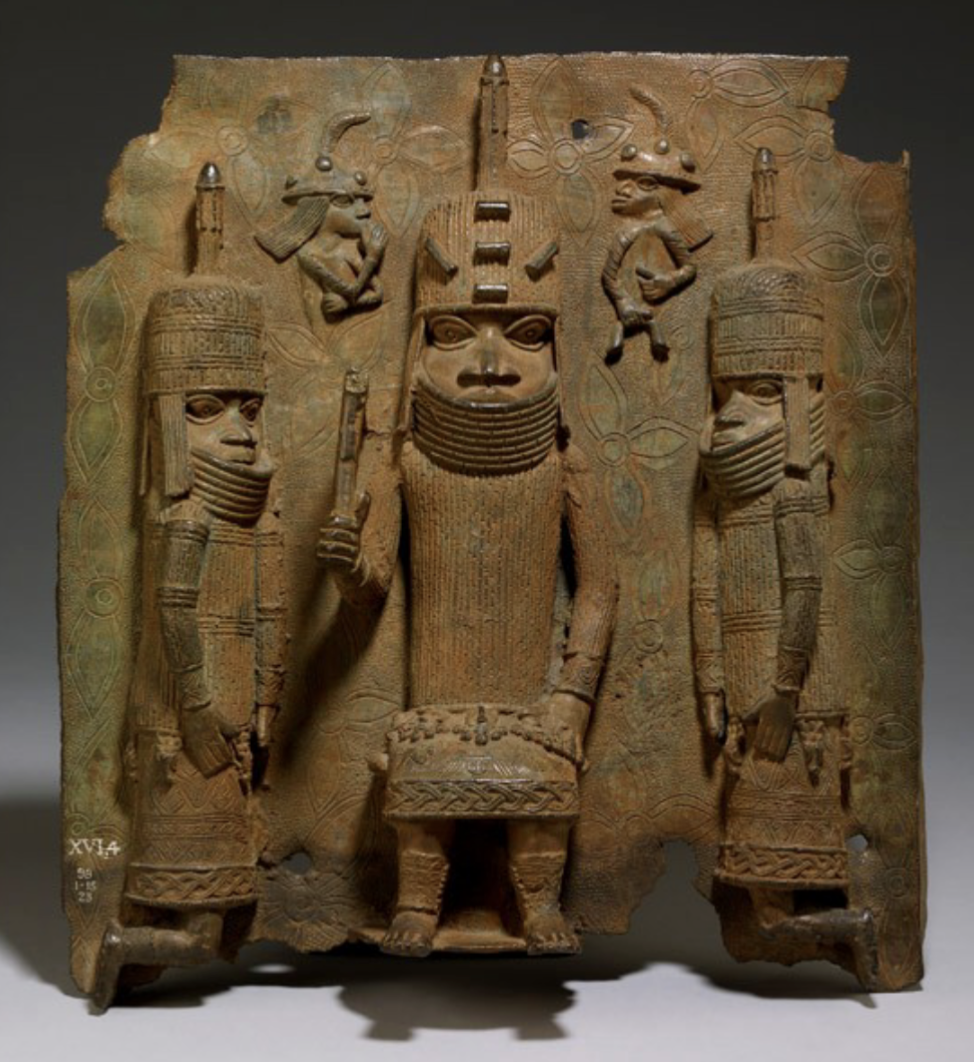
“Plaque of The Oba with Europeans” notes
Oba Esigie (I think)
europeans (portuguese) are the funny looking little guys in the background
not very important & not the focus, they just happened to be there
long hair, different hats, buttons, odd poses
Artwork ID: “Royal “Osun” Spirit Head”
Kingdom: Kingdom of Benin
Location: Nigeria
Dates: c. 1,200CE - 1,897CE
Medium: bronze
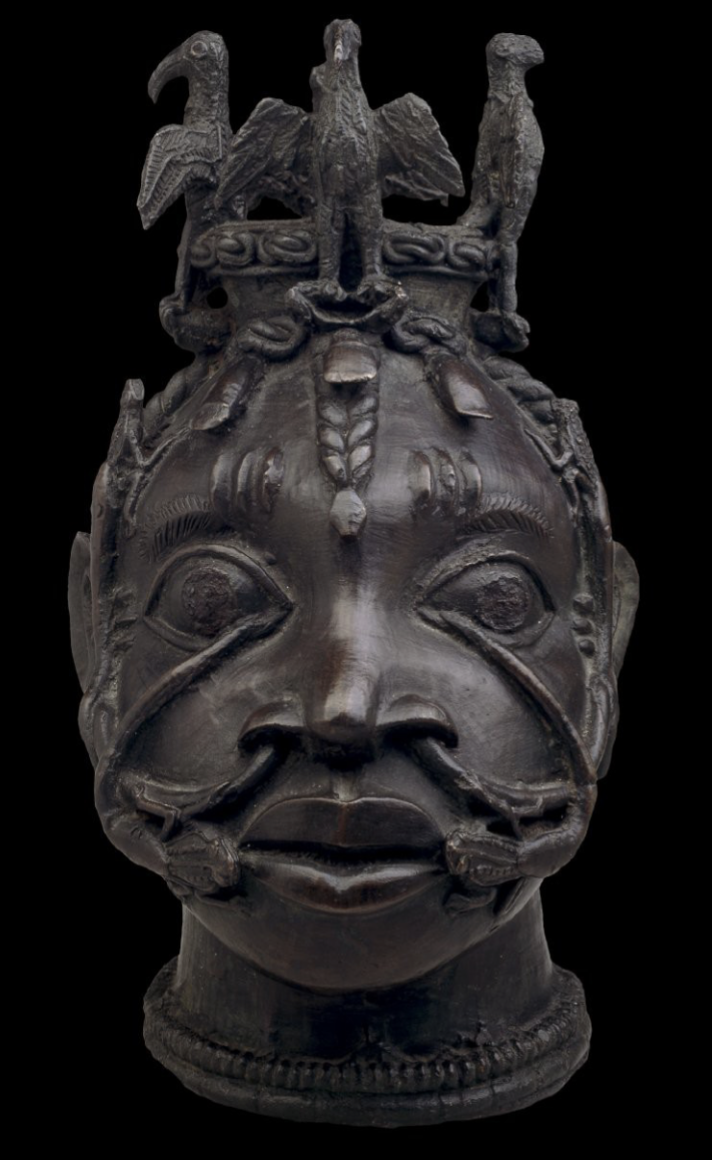
“Royal “Osun” Spirit Head” notes
deity that resides in leaves and herbs, typically portrayed with snakes around the face
honoring ancestors
could speak to ancestors through them
Benin Post-Exile (dates)
c. 1,914CE - present
Benin Post-Exile (c. 1,914CE - present) notes
after the Benin Massacre the British looted and colonized the area, taking control of Benin and exiling the Oba (Oba Ovonramwen)
artifacts were stolen and kept by soldiers/officials or exported and auctioned off to museums
none of the museums have returned the artifacts in their possession (of f*cking course)
museum in Benin is currently being built and is scheduled to open in 2025
hopefully will prompt museums to return artifacts
a figurehead Oba was eventually installed (Oba Akenzua II) but the British still have power
Artwork ID: “Oba Ovonramwen”
Artist:
Culture: Benin Post-Exile
Location: Benin, Nigeria
Dates: c. 1,914CE - present
Medium: stone
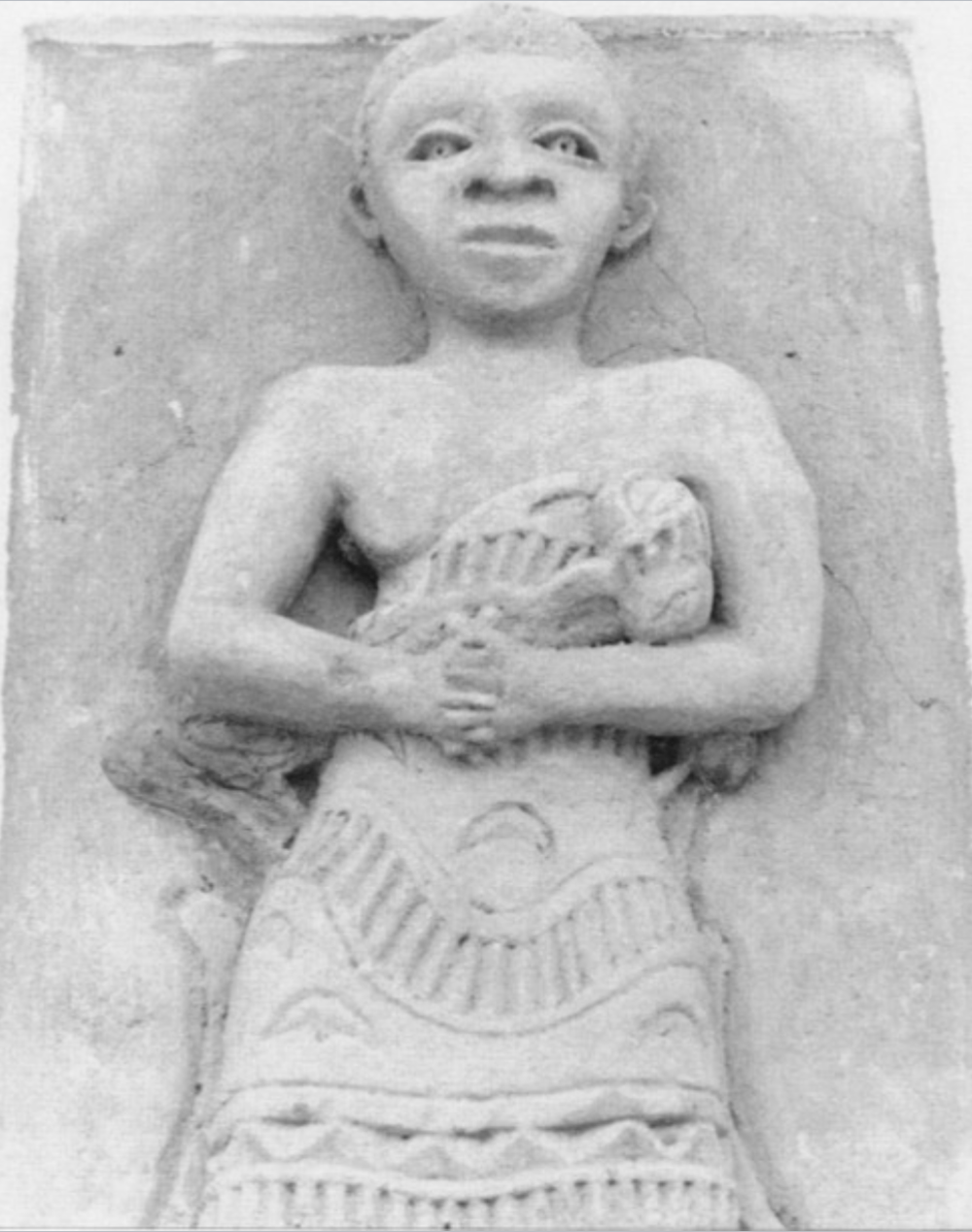
“Oba Ovonramwen” notes
Oba exiled after the Seige of Benin in 1897
based on an image of him being exiled by the British
head is uncovered, seated, folded arms, not much ornamentation
Oba
divine king of Benin
means “great head”
ikharo marks
vertical marks above the eyebrows that indicate the gender of the figure
3 = male, 4 = female or foreigner
only on sculptures, not real life
eben sword
a fan-like ceremonial sword associated with the court of the oba of the Benin Kingdom
used to pledge your allegiance to someone
the Oba is never depicted holding it
conventional portrait
typical representational portrait
Osun
deity that resides in leaves and herbs
typically portrayed with snakes around the face
Oba Esigie
3rd of 3 Great Obas (Ozolua's son)
most "cosmopolitan" Oba
established strong diplomatic relations with Portugal; also made a religion that mixed Catholicism with traditional Benin religion
depicts himself differently based on the audience (in Ovia cult garb to show local relatability, in European garb other places, etc.)
Iyoba
queen mother (Oba's mother)
can't see son once he becomes king b/c there would be too much power in one spot
ekpate
women employed to stay in the palace and protect the king from spiritual attacks
Punitive Expedition/Siege of Benin
British come to trade during time where Oba has to stay inside for ritual purification, they were told to leave
quarrel w/ Benin guards led to several British merchants killed
burned the palace and stole all of the bronzes and artifacts
exiled Oba Ovonramwen
emblematic portrait
a symbol of someone (such as a leopard) to represent someone in a piece
Oba Oranmiyan (Benin)
the mythical founder of Benin
grandson of first Oba (1st Oba= grandson of Obatala)
takes over Ibini/Benin
1st king of 2nd Benin dynasty
thunderstone
perfectly round/smooth stones said to have broken off from heaven when lightning struck
if you found one, you would have to bring it to the palace as an offering
Ibini
means "land of vex"
probable origin for "Benin"
Olokun
the god of the sea, wealth and creativity in the kingdom of Benin, who was responsible for abundance and prosperity
Oba Ohen
portrayed with fish for legs as a metaphor for his disability
the Oba that killed a courtesan for finding out about it and was punished for it
turned into a cautionary tale
tableau portrait
shows multiple figures in one composition but focuses on one figure
Ogiso
9th century, before Benin
very polititcally dysfunctional
nicknamed “Ibini”